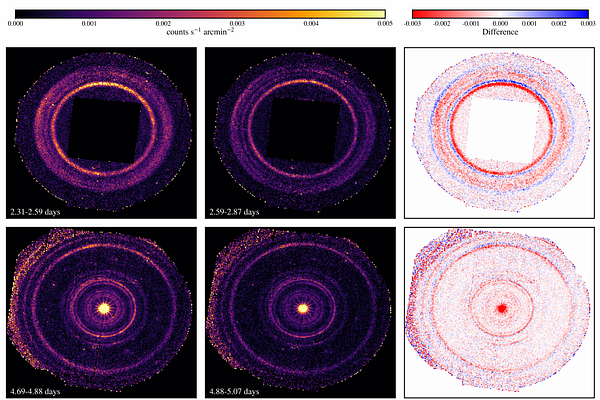The optical constants and grain sizes of interstellar dust measured directly using the dust scattered x-ray halo of GRB 221009A

The optical constants and grain sizes of interstellar dust measured directly using the dust scattered x-ray halo of GRB 221009A
Albert Sneppen, Darach Watson
AbstractX-ray scattering is a powerful probe of the optical constants and grain size distribution of interstellar dust. Bright, transient sources are excellent tools for this, since they fade rapidly, leaving only the expanding scattered x-ray halo. Here, we analyse the dust-scattered x-ray halo data of the unprecedentedly bright $\gamma$-ray burst, GRB 221009A, using anomalous diffraction theory to measure the grain size distribution of dust in the Galaxy as well as the complex refractive index, $m$, and use these results to infer the likely composition. We find a complex refractive index, $m=n+ik$ at several x-ray energies, finding $k_{1\,\mathrm{keV}}= (2.7 \pm 0.7)\times10^{-4}$ and $1-n_{1\,\mathrm{keV}}= (9 \pm 2)\times 10^{-4}$, strongly inconsistent with the commonly employed assumptions of the Rayleigh-Gans approximation. These results lie in the expected range for interstellar dust compositions dominated by carbon, magnesium silicates, and iron. The absorption results suggest a substantial mass fraction of iron at $35\pm7\%$. The MRN distribution fit returns a maximum grain radius, $a_{\rm max}=0.24\pm 0.01\,\mu$m; all fits strongly rule out models with $\sim0.4\,\mu$m grains for this sightline. The soft x-ray spectrum of the prompt GRB can also be inferred from the fitting, with the best-fit providing a spectral slope that is consistent with the slope of the low energy side of the best-fit Band model of the directly measured prompt emission. Forcing a different grain size or composition than the best fit results in an inferred prompt spectrum different to the observed prompt emission. The refractive index is consistent with standard average dust compositions, showing that x-ray scattering is an effective tool to measure interstellar dust optical properties. [abridged]